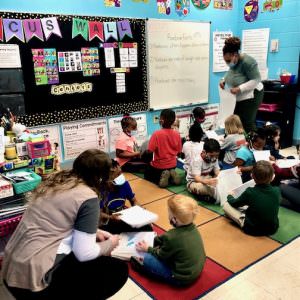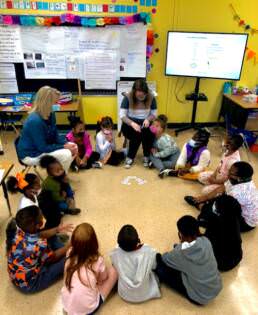Co-Instruction in HCS
Co-Instruction in Haywood County Provides Equity and Inclusivity in the Classroom
Elementary schools in Haywood County are partnering with the National Institute for Excellence in Teaching to implement a teaching philosophy that will help provide equity and inclusivity in the learning environment.
Thinking of traditional modes of K-12 education, a seven-hour, five-day-a-week schedule comes to mind. Instruction is handled by one teacher in a class of 20-25 students. Not much in education has shifted in major ways over time. HCS schools and NIET are challenging the narrative of tradition and looking instead at the best ways to serve all students in the classroom.
Dr. Dexter Murphy is a representative with NIET and is partnering with HCS Special Education Instructional Specialist, Denise Pearson, to help schools implement co-instruction practices in some classrooms in Haywood County.
Co-instruction at its most basic level is a way of teaching that involves two professionals in one classroom of students using each or all of the six co-instruction techniques listed below depending on what students need at a given time.

Six Techniques of Effective Co-Instruction
1. One teaching/One assisting – In this model, one teacher is giving direct instruction and the other teacher is assisting students in the classroom.
2. One teaching/One observing – One teacher is directly instructing the class while the other teacher is observing best practices and taking notes on students and/or instruction.
3. Stations Teaching – In this model, students are divided into two or three groups with each group receiving a distinct lesson from one teacher. The third group is working independently. Each group rotates until each has experienced every learning station.
4. Parallel Teaching – Two inclusive student groups are taught the same lesson at the same time by each teacher.
5. Alternative Teaching – One teacher provides instruction for a small group of students while the other teacher works with the larger group.
6. Team Teaching – Both teachers provide instruction to the class together. The two teachers take turns instructing, modeling, charting, etc.
Each of these techniques is an effective way of co-instruction, but one is not necessarily better or more practical than the others. The primary purpose is to meet students’ needs because each student learns in their own way.
“There’s no best model for co-instruction,” Dr. Murphy explained. “It’s best for whatever the students need. That’s what equitable instruction is.”
Equitable and inclusive instruction is something that must be intentional if both are to be done successfully in schools. Co-instruction is an excellent way to meet each student where they are as a learner and give each student equal opportunity to progress in their educational journey.
“Some advantages that co-instruction provides are multiple perspectives and multiple strategies,” Dr. Murphy explained. “In an ideal situation, you shouldn’t be able to see who’s a special education student or general education student or a special education teacher or a general education teacher. Every student has different learning styles and will respond differently to various types of instruction.”
As Special Education Instructional Specialist, Denise Pearson understands the importance of providing all students with the best options and avenues for learning.
“We have diverse learners in every classroom. EVERY classroom is an inclusion classroom,” Ms. Pearson said. “We all learn differently and we have to change that traditional mindset of one-way teaching and learning. With co-instruction, we have two professionals with different styles and perspectives and it can more effectively meet student needs within a diverse classroom.”
Denise also knows that this wouldn’t be possible without support from the highest levels in the district.
“Superintendent Hassell’s and Deputy Superintendent Davis’s leadership, shared vision, and support around equity and inclusivity help to make this work possible for HCS,” Denise said.
Learning to co-instruct is a malleable process that is allowed to shift and grow as collaboration continues between NIET and HCS. There will be monthly trainings and real-time coaching for the co-instruction classrooms.
“We’re customizing our support specifically for this district. It’s hard work but it’s heartfelt work,” Dr. Murphy said.
Adapting and evolving are both necessary and long overdue in education. Haywood County is taking steps to grow with students as their learning needs change.


